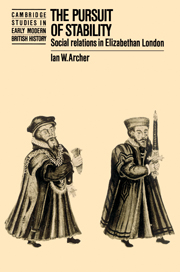Book contents
- Frontmatter
- Contents
- List of figures
- List of tables
- Acknowledgements
- List of abbreviations
- 1 INTRODUCTION: THE PROBLEM OF ORDER
- 2 THE FRAMEWORK OF SOCIAL RELATIONS: THE CITY ELITE
- 3 THE FRAMEWORK OF SOCIAL RELATIONS: LOCAL GOVERNMENT, NEIGHBOURHOOD, AND COMMUNITY
- 4 THE FRAMEWORK OF SOCIAL RELATIONS: THE LIVERY COMPANIES
- 5 SOCIAL POLICY
- 6 CRIME AND SOCIETY
- 7 CONCLUSION
- Bibliography
- Index
- Cambridge Studies in Early Modern British History
- Frontmatter
- Contents
- List of figures
- List of tables
- Acknowledgements
- List of abbreviations
- 1 INTRODUCTION: THE PROBLEM OF ORDER
- 2 THE FRAMEWORK OF SOCIAL RELATIONS: THE CITY ELITE
- 3 THE FRAMEWORK OF SOCIAL RELATIONS: LOCAL GOVERNMENT, NEIGHBOURHOOD, AND COMMUNITY
- 4 THE FRAMEWORK OF SOCIAL RELATIONS: THE LIVERY COMPANIES
- 5 SOCIAL POLICY
- 6 CRIME AND SOCIETY
- 7 CONCLUSION
- Bibliography
- Index
- Cambridge Studies in Early Modern British History
Summary
We saw in the introduction how the absence of a conflagration in London in the 1590s belies the very real tensions to which the social and economic pressures of that decade contributed. Londoners turned against the traditional scapegoats for economic misfortune, the aliens resident in their midst, and in 1592–3 the aldermen confronted the very real possibility of a repetition of the rioting that had characterised Evil May Day in 1517. But more serious developments lay ahead. It was especially worrying to the elite that during the escalation of economic difficulties in the years which immediately followed the attacks broadened and members of the elite were directly criticised.
The social fabric was highly flammable, but it failed to ignite. A key variable in ensuring that stability was maintained was the cohesion of the elite, a lesson which is obvious from a comparison of London in the 1590s with earlier less stable periods in its history and with other European cities at the same time. That London escaped the fate of Paris was due to England's successful containment of the religious passions unleashed by the Reformation. The catholic threat in the capital had long since receded. There is little sign that the London elite's forward protestant façade cracked during the 1590s, and although some, like Alderman Richard Martin, had probably favoured still more radical forms of protestantism, there was little desire to rock the boat in the 1590s in view of the queen's commitment to war against the Antichrist, while Whitgift's policy of isolating the presbyterian contagion proved remarkably effective in reminding most puritans, in London and elsewhere, of what they had in common with the Established Church.
- Type
- Chapter
- Information
- The Pursuit of StabilitySocial Relations in Elizabethan London, pp. 257 - 260Publisher: Cambridge University PressPrint publication year: 1991

